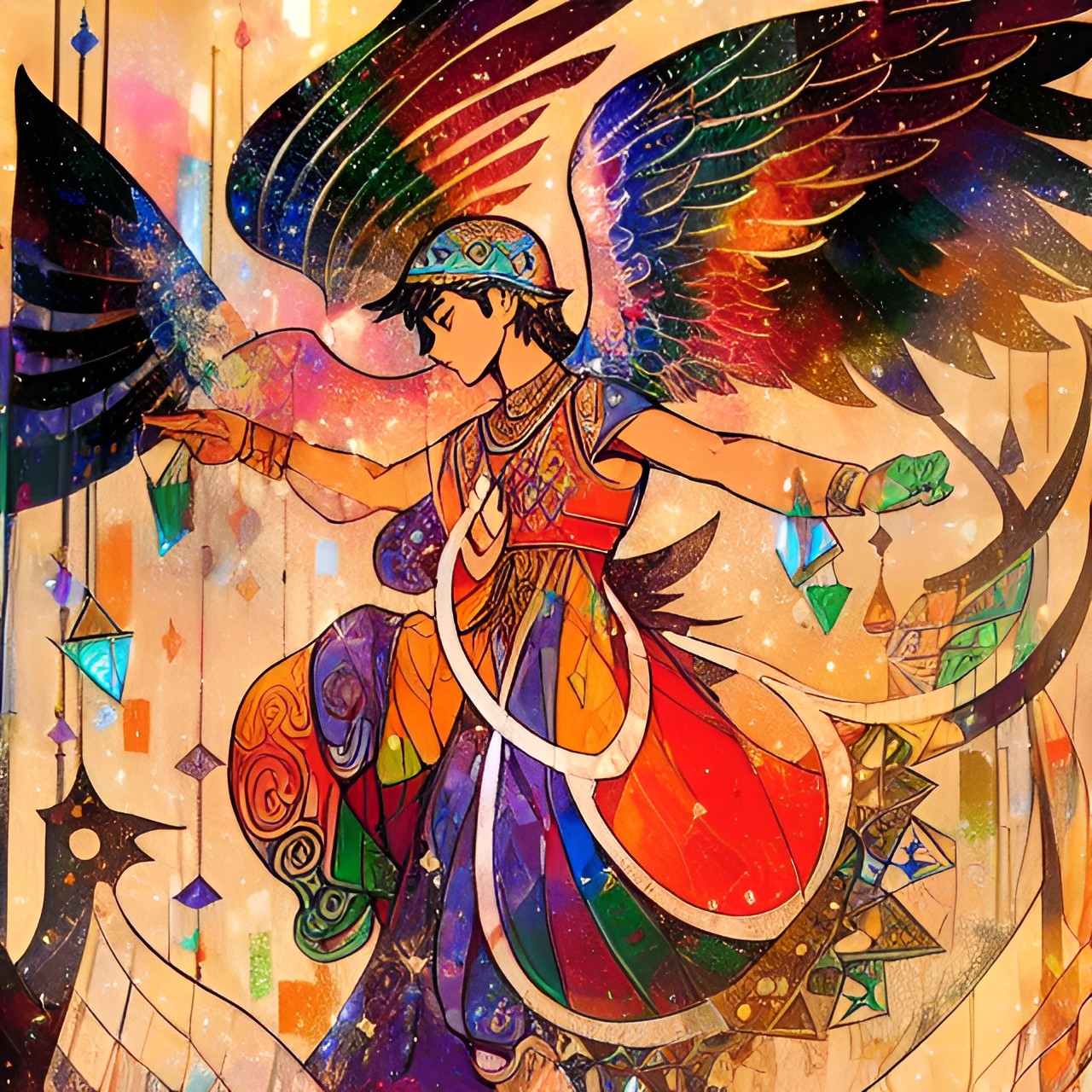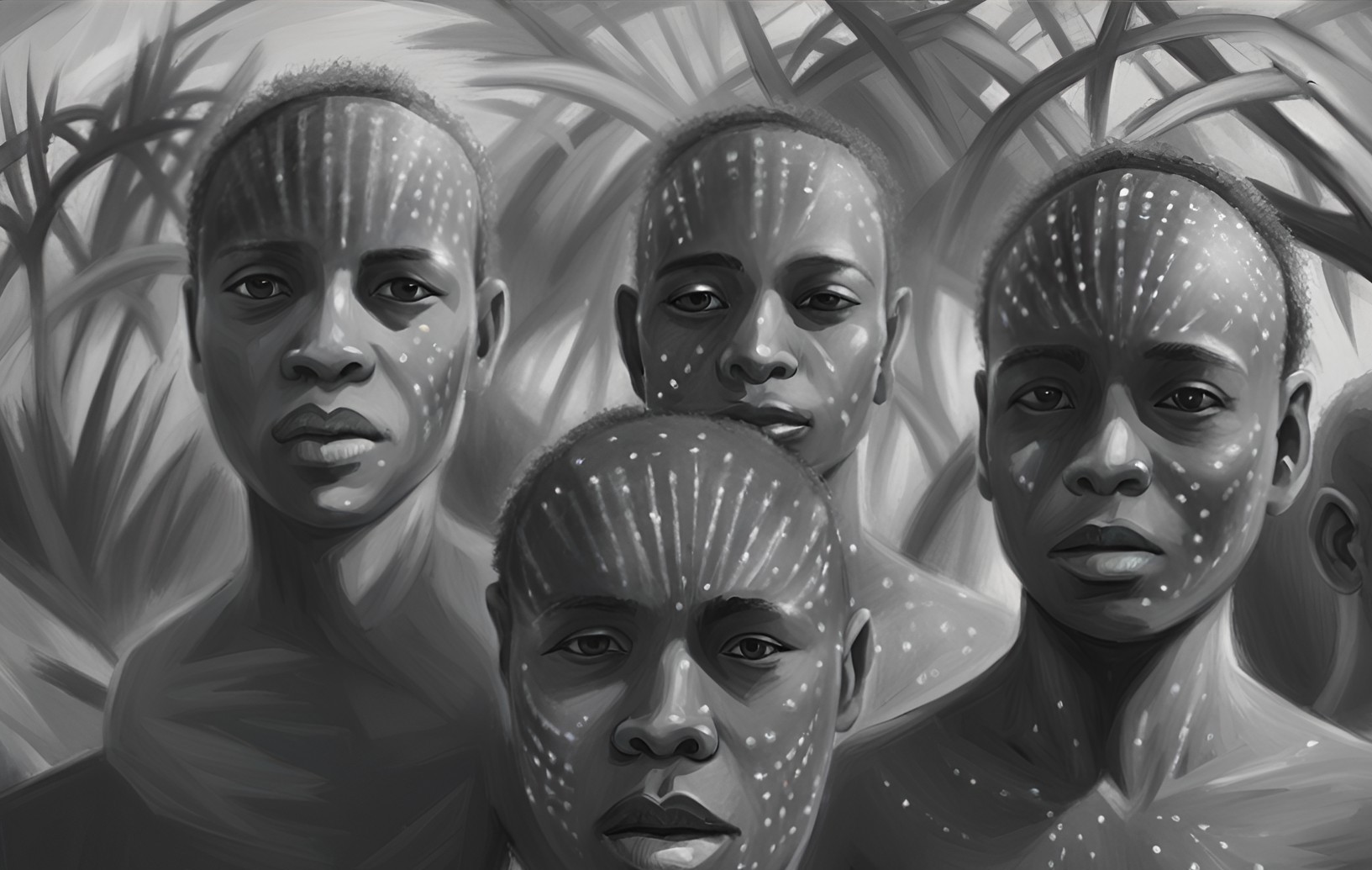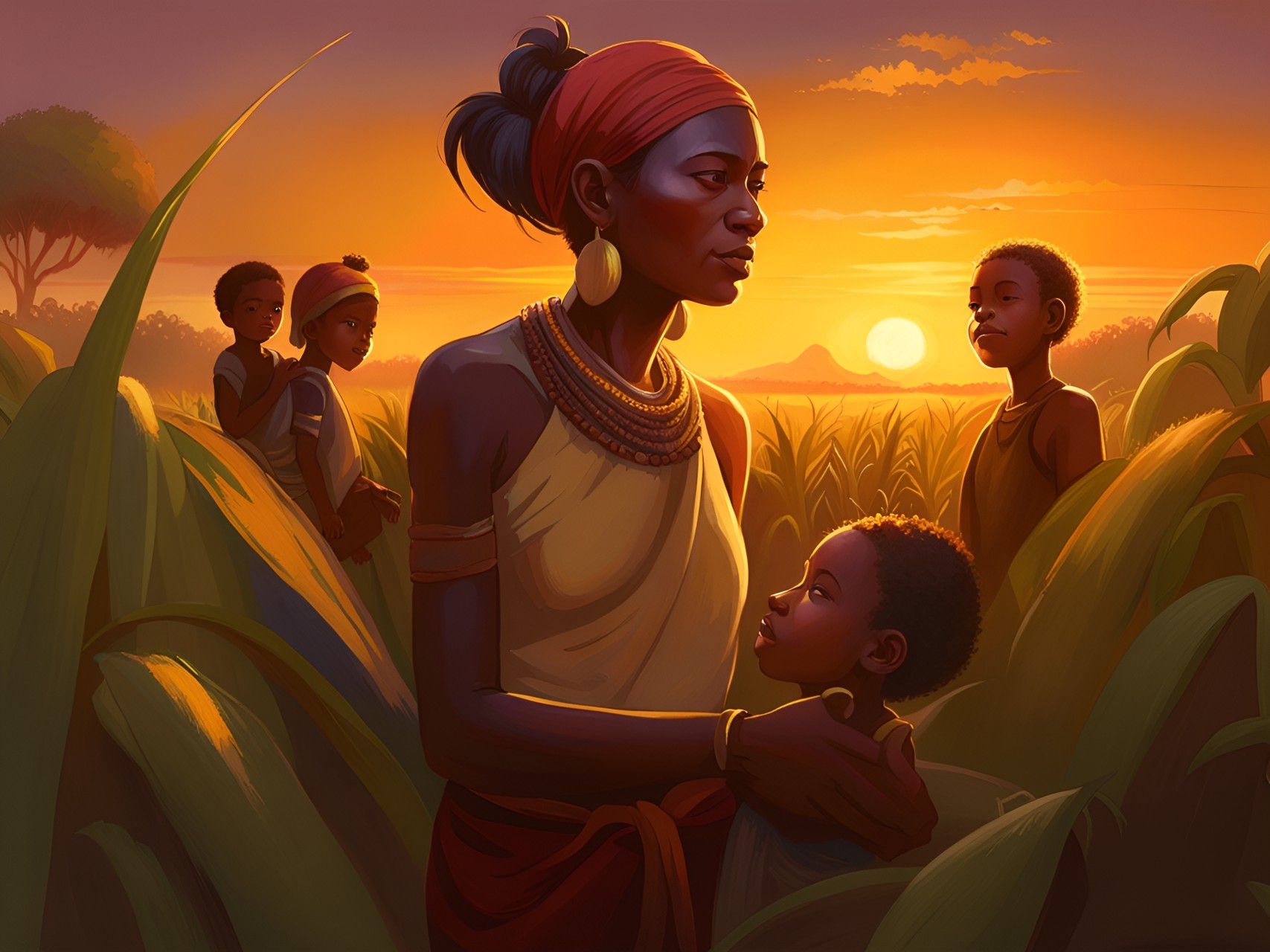Kameeni
These gregarious tribes live along the southern borders of the Shamsi Desert and central regions of Kasar Wuta. Most Kameeni villages can be found weaving between river valleys and flat savannahs, especially along the Shari River south of Lake Sade, subsisting on a mixture of fishing and sedentary agriculture. They are the largest ethnic group of this region, made up of patrilineal clans which were once united into a single political entity. Now they are a longheld and ready ally to the Kingdom of Accia, providing a reliable foothold in central Alkelbulan.
Among Kameeni tribes, Flithmar and Rithaldis' blessings are the most common but occasionaly Kanilwyr or Rylmar magic surfaces or some kind of Vision manifestation. Common manifestations include Aura, Movement, Slip, Sense, Eye, Skin, Pocket, Will, Shield and Form. These are usually used to aid in their agricultural labors such as summoning miniature suns to nourish their crops or diverting wildfires while others are more useful for craftsmanship or warfare. They are apt in using their magic for metalworking, pottery, weaving and woodworking. Those with mental magic are best suited for healing or acting as religious specialists within their communities while mages are believed to possess their own besi, spirits.
Naming Traditions
Family names
There are different clans and tribes a Kameeni can belong to, each considered their own political entity. These include the Kaba, Sar, Nar, Gulay, Ngambay and Mbay. Ngambay are the largest tribe followed by the Gulay and then Sar. One can usually differentiate these tribes by the scarification patterns on the faces and bodies though this is becoming less common thanks to Accian influence.
Culture
Major language groups and dialects
There are more than a dozen languages spoken by the Kameeni, all of which fall under the Bongo-Bagirmi umbrella and the Nil-Shamsi branch as a whole. Kameeni consider each of their spoken languages distinct from each other rather than grouping them all together. The most common of these is Ngambai, uses most for trade in their southern territories, but Sar is also common. Others languages include Laka, Kabba, Bedjond, Bebote, Mango, Gor, Nar, Mbay, Ngam, Dagba, Gulay and Horo.
Culture and cultural heritage
Some Kameeni in the Shamsi Desert have converted to Islam al'Rasul thanks to Arabiyy invasion and influence, pressured relently over the course of many eras, but most have retained their traditional beliefs nonethless. This has made them a target for Ilnid's empire, attempting to fully push them out of the Shamsi Desert or enslave those who refuse to convert. They are also occasionally the target of Fulbe invaders.
When Accian influence spread into Kasar Wuta, the Chevalier House allied themselves with the Kameeni and promised to drive out their Arabiyy invaders, a promise they kept... for a price. As a condition in their treaty, it became manditory for Kameeni teenagers to enroll into the Accian Military Training Program and eventually service in the Accian Military. Assured they would be provided the best combat training and education available, Kameeni youth optimistically joined AMTP. While they received the education they were promised, never would have imagined how much this would effect the culture and loyalties of their children, drastically assimilating the Kameeni people into the Kingdom of Accia. Their continued alliance has given the kingdom a solid central foothold in Alkelbulan which they continue to rely on today. Only those living within isolated villages of the Shamsi Desert have retained their cultural individualism.
Shared customary codes and values
There are no ranks within tribes, the Kameeni are an egalitarian people. While outside influence has made hierchy more prevalent, primarily in regards to military structures, the most distinguishing characteristic among the Kameeni is age. Most Kameeni believe one should never defy their elders. They also believe women should defer to men. However, kin are expected to always assist their relatives, especially those which are close relatives. For this reason, men usually don't exert excessive authority over their wives because he might lose the support of her relatives.
Common Customs, traditions and rituals
Most Kameeni live in small villages along rivers and major roads called gir begi. Heads of family are gir ka, living together with their wives, children and kin. Gir begi are divided into households with circular thatched huts centered within a family's field. Most make their homes within the river valleys of Kasar Wuta but there are a number of small northern settlements in Shamsi oases or wadis. They subsit off of well watered cereals like sorghum and millet but taro, yams, and sweet potatoes are also common. Kameeni men are also fishermen and raise Tamadla Goat, Aa-hemet Donkey and Impangele Hen. Some villages have been introduced to and encouraged to grow Eluzian crops by the Kingdom of Accia, especially cotton, but these are far less tolerant of the frequent wildfires native species can endure or even thrive by and aren't as tolerant of the extreme heat.
There is no special access to their most important resource, land, and there are no ranks within tribes. Land is exclusively farmed by members of a given clan. Clan members acquire whatever land they farm, whatever land they work themselves. However, non clan members can also gain the right to acquire fields with permission from the proper clan. Land isnt inherited but, in a sense, earned through labor. Agriculturally, they practice slash and burn, leaving fields fallow for some time to rest. It isn't uncommon for them to use fire and radiant magic to invigorate or protect their crops and livestock and their villages are constructed to be entirely fireproof! They do so by building their houses and creating firebreaks out of materials immune to or which resists fire, Mawa Palm extremely popular for these purposes while Maliha Tamarisk are excellent firebreaks.
Coming of Age Rites
Initiation of young into the tribe occurs every seven years over a duration of two months. Body scarification is practiced for both men and woman and is a symbol of their community. This is a painful process for those undergoing initiation but most face it with pride if not anticipation. Interestingly, these scars are infused with a secret combination of materials from the Shamsi Desert which cause their scars to gleam with sunlight when they use magic or activate their forms! It is believed these scars connect them to their ancestors and they display cultural or tribal affiliation wherever they go, each tribe using different patterns. Across tribes, linear patterns are usually reserved for men while woman receive circular or crescent-shaped patterns.
The Kameeni believe by undergoing this initiation they learn various lessons such as "there is pain in this world, and you will feel pain in your life, but the pain will stop if you can endure" or "we are showing the children where they are from and what they will go through in life". Initaition is meant to test bravery and endurance, acting as a gateway into adulthood. They are seen as better capable of facing injury, death or the trauma of childbirth. These ritauls have slowly become less common thanks to Accian influence who find the custom and appearance barbaric. Despite this, there are many who purposefully undergo the process as an act of defiance, resistance to outside influence or as a symbol of their cultural heritage in spite of Accian values. In these cases, they usually undergo the process just before joining AMTP.
Common Myths and Legends
The Kameeni religion is animistic, revolving around the belief that religious specialists can influence supernatural forces through rituals, restoring and maintaining the wellbeing of their communities. There are a few major entities, these being Nuba, besigi and badigi. Nuba is a deity which they believe created the world, a maternal figure usually associated with Lithmor and her aspect Rithaldis. Sunlight is seen as a giver of life and they believe the Kameeni are her children. Besigi are spirits existing within, symbolizing and named after objects like trees or social activities like initiations, readily associated with aspects and aethid. Besigi are spirits who can interfere in people's lives and cause misfortune when displeased. Badigi on the other hand are the souls of the dead in the afterlife. They believe badigi can attack people and cause misfortune like the besigi, many of their rituals focused on pleasing or winning over besigi and badigi.
Religious practitioners includes those who own besi (usually mages), mohgi who oversee initiations, those in charge of harvest festivals and rainmakers. Kameeni have no organized religion, except among the mbang of Bedaya, but kin are expected to participate in rituals. These include initiations, funerals and harvest festivals. Initiations are used to define gender roles and mark coming of age. Those iniatiated are ndo while children or uninitiated are koy. They also believe illness is caused by besigi, badigi or, in rare cases, by a sorcerer called kuma. Divination techniques are used to identify the attacker and find a diagnosis. Death isn't viewed as an event by the Kameeni so much as change in social status. They believe the soul of a person, their ndil, is separated from their body when they die. So long as the right rituals are performed, the deceased is believed to become a badigi.
Historical figures
According to their oral history, the Kameeni descend from the Sao civilization, thriving within central Alkelbulan for nearly a millenia. They revered Lithmor as a creator goddess, Nuba, and her aspect Rithaldis in particular. Because of this, they are sometimes called "Sara" by their northern neighbors which means Sons of Ra. They once lived along al-Nil River but were driven out by Arabiyy raids long ago as Islam al'Rasul swept through northern Alkelbulan, migrating east to escape these hostilities. In fact, they are closely related to the Nilot peoples.
The Sao were a major civilization within central Alkelbulan amid the early days of Emynea, revering Rithaldis. They mainly lived along the Shari River south of Lake Sade after migrating east from al-Nil. Their decline began with the birth and rise to power of Ilnid, creating a schism among followers of Islam north and south. Hostilities worsened between the Sao and Arabiyy amid this schism, unwilling to abandon their faith in Rithaldis and quickly making themself an enemy of Islam al-Rasul. This would eventually lead them to their downfall. After a long period of warfare with the Arabiyy, this civilization fell instead to the Kanembu peoples. Their city-states remained, inherited by Kameeni descendants. In their art, the Sao are often presented as giants and mighty warriors.
Ideals
Gender Ideals
Within Kameeni culture, woman are supposed to work their husband's fields and perform domestic activities. Husbands are expected to provide their children with food through fishing or other means alongside most other necessities. He usually owns the fields and their harvest, having control over how these are dispersed. As woman grow older, they ususally clear out and plant their own fields, owning what they produce. Laboring in the fields is expected of any kin, especially children. Gender isn't considered when hiring laborers, generosity being the most sought after quality whether this be with their grain, alcohol or cooked food. When land is abundant, this allows for egalitarian access to food.
Courtship Ideals
Marriage among the Kameeni is intrinsically tied to exchanges and generosity. Their word for love, tar, also means "giving things" and is synonymous with "deep affection". In their ideal marriage, a husband gives his wife grain while she provides labor. Payment of bride-wealth, of some form of payment from the groom to the family of the bride, is a necessary step in marriage which gives men sexual rights to his bride and possession of their children. Men can take several wives while widows are expected to remarry. Despite this, divorce is also possible but most women can open their own fields to gain independance. A man usually builds his wife or wives houses adjacent to that of his own father, becoming an extension of his family. Marriages are usually arranged outside of one's own clan or tribe.
Relationship Ideals
Kameeni practice a cognatic, ancestor focused family system with patricians. Patricians are wealthy landowners from old families and a cognatic system is one of bilateral kinship where family lines are traced through both one's father and mother. They have a term, gir ka, which means ancestor or patrician, someone a person descends from in any way. They believe kin should join in each other's work groups, share food, be welcoming to other members and provide support to each other in whatever way. Gir be on the other hand refers to patrilineal lines. Clan members are expected to participate in funeral ceremonies and clan affairs like vengeance parties or sacrifices to the spirits. The process of raising children is considered intensive, children expected to learn and behave, punished when they fall outside of these expectations or gender roles. Formal education has become important to the Kameeni who respect the AMTP program for all they believe it provides them.
Major organizations
Most tribes lack any single leader or head of their communities beyond their gir ka. However, increasing hostilities with the Arabiyy and Fulbe led some of these tribes to adopt chiefdoms especially among the Sar, Nar and Gulay tribes. The Sar organized around a leader called a mbang and established the town of Bedaya. This became the center of their collective culture with the addition of Accian patronage. However, those tribes living within the Shamsi Desert resent these changes to their traditional way of life, even leading to conflicts between northern and southern tribes bordering on revolution.
There are no courts or executive power in these tribes. Most conflicts are handled internally but in the cases of murder and the like, a veangeance party is usually formed composed of a victim's closest relatives. Outside forces were primarily Arabiyy and Fulbe, some of these being slavers. Now, with these forces all but eliminated from their lands their primary conflict is between northern and southern tribes concerned with the altercations to their traditions and blind loyalty to the Kingdom of Accia. Many believe they've sold their soul to the kingdom which considers them a annexed territory even if the exact wording is more along the lines of an alliance.













Comments